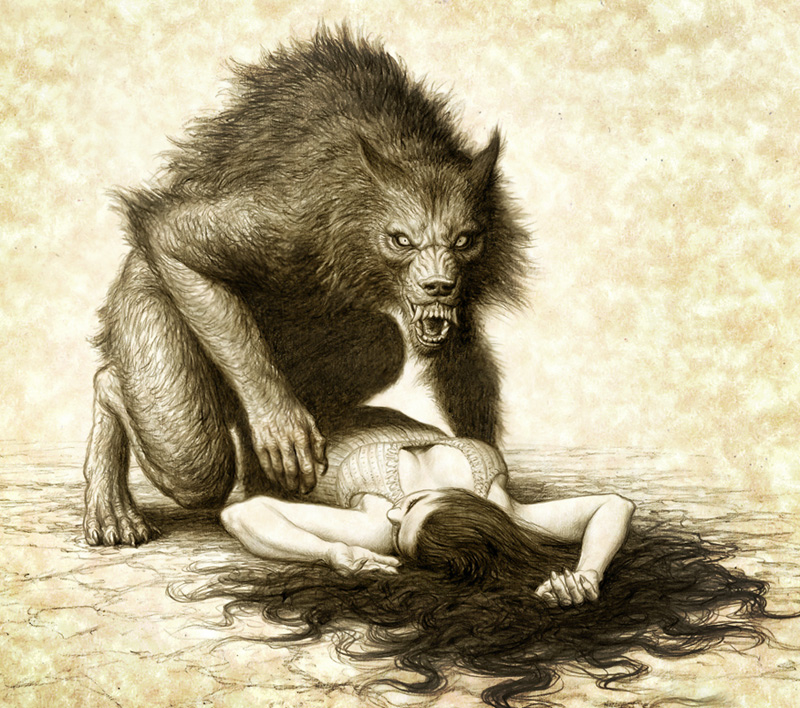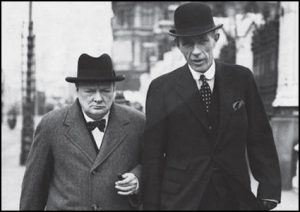Have you ever heard that at night the creatures come out, especially when there is a full moon. But whenever people think of a full moon, the thought of a werewolf might cross their mind. Because of the famous movie Twilight: New Moon, which was released in 2009, people might imagine a werewolf being Taylor Lautner turning into a huge wolf. However, before this movie was released to the big screen, werewolves were thought to be a thing of the night, actual monsters to fear.
In the past, werewolves are said to be the product of a human’s involuntary, typically only temporary, transformation into a wolf.1 They didn’t necessarily completely change into a full wolf, but had the appearance of being half-wolf and half-human. For quite some time during the medieval period, many couldn’t accept the fact that a man could transform into a wolf. They concluded that these werewolves were a product of magic, that witches used their magic to transform someone into a wolf, known as lycanthropy. With the use of magic, these werewolves were considered voluntary werewolves, as oppose to involuntary werewolves, who shifted into wolves because of their sins.2 After the transformation was made, people assumed a werewolf was a servant from the devil himself, and anyone accused of being one was put to death.3

The origins of these beliefs started in the Balkan area. In this region, the Dacians, who were an ancient people, had a wolf as their totem animal. With this being said, they believed that they were able to turn young men into wolves when performing a ritual.4 When this ritual was performed, they would imitate a wolf along with wearing wolf skins; this is because they believed the wolf should be highly respected for being a hunter. Even in Greek mythology, one can find stories about men transforming into a wolf. They told the story that the mighty Zeus became angry at a man named Lycaon, and for a punishment, he turned Lycaon into a wolf. With this story we get the term lycanthropy. However, some people believe that werewolves may be a relic of early cannibalism rather than just beings consulting with the devil. Communities of semicivilized people would begin to shun those who devoured human flesh, ostracizing them and classifying them as wild beasts.5 People who would willingly choose to eat a human being are not really human, but rather a beast, because they behave just as beastly as a wild animal.
The belief of werewolves may seem fictional to us today, but in the 1500’s, these beasts were thought to be completely real. In 1407, Basel Switzerland authorities claimed that they had the first official execution of werewolves, with several individuals being accused, then tortured and burned.6 Werewolf trials then took place in Poligny, France in 1521, when three men claimed they were consulting with demons in order to gain the power to transform into wolves. The men then confessed that they had killed and consumed several children for nineteen years. All three men were then burned at the stake.7

In the following years, many cases of people being werewolves were brought forward. One of the most famous cases was of Gilles Garnier in Dole, France 1573. No one understood why several young children disappeared in 1573, until Garnier and his wife were arrested and tried as werewolves. Garnier confessed that he had killed a twelve year old boy, and was going to consume his flesh, but was interrupted before doing so. Although he was in human form, some citizens claimed that he had appeared as a wolf. In his confession, he claimed to have killed a ten year old girl while being in the shape of a wolf, using his teeth and claws to devour her.8 He also claimed to have attacked a girl but was again interrupted; several days later he strangled a ten year old boy, ripping his leg off and eating his flesh. In both incidents he claimed that he was in wolf form. After all of his confessions, he was then burned alive on January 18, 1574.9

In another known case, a man named Peter Stubbe also claimed to be a werewolf. He possessed a magic belt that allowed him to transform from man to wolf. Although authorities never found his belt, he was beheaded for his crimes in 1589.10
Finding evidence of real werewolves was tricky, until 1598, with the case of Jacques Roulet. A group of hunters stumbled upon two wolves devouring a fifteen year old boy. Since they were armed, the hunters decided to follow the wolves. When following the tracks, the paws slowly started to become more human like. They finally reached the end of the tracks, finding a man with long hair and a long beard, wearing rags, his hands covered in blood, and his long nails contained bits of human flesh. Jacques claimed he had possessed a salve that would enable him to turn into a wolf.11 Although the cases of werewolfism died down, the idea of being a werewolf never disappeared.
Over time, the phenomenon of werewolves took a new shape. In 1935, the movie Werewolf of London opened, introducing a cinematic version of these supernatural beings. The plot of the movie was inspired by the true story of Francis Bertrand. Bertrand had been convicted in 1848 for breaking into several graveyards in Paris. He would dig up recently buried corpses and consume their flesh.12 The story was then transformed into a movie about Bertrand Caullet, a person who didn’t have the knowledge of being a werewolf until being shot with a silver bullet. The silver bullet was significant, as it became a reoccurring theme in later movies, including Frankenstein Meets the Werewolf in 1943, and later in An American Werewolf in Paris in 1997. With the use of the silver bullet, people stepped back from thinking of beheading or burning people at the stake as ways of killing these beasts. The concept of using a silver bullet emerged from the Scottish belief in the efficacy of using silver to kill witches.13 Another modern adaptation that emerged was in the ways one would become a werewolf. In the past, in order for you to transform you needed the help of a witch or magic, but that started to fade. Today popular culture has transformed the original belief into one that sees being bitten or scratched by a wolf or werewolf in order to become a werewolf. The reason for this change started with The Wolf Man film of 1941.
By the 1970’s, werewolves had become very popular in genres of horror: in movies, in books, and even in television shows. With the franchise of werewolves still growing, there are less cases of werewolfism today. Many doctors believe that what people witnessed wasn’t an actual werewolf, but rather a person suffering from a serious mental illness, along with a condition called porphyria. Porphyria causes people’s skin to turn brown and oddly textured. People who suffer from this disease also become sensitive to light, making them more comfortable with venturing out at night.[13. Encyclopedia of Occultism and Parapsychology, 5th ed., 2001, s.v. “Werewolf.”] However, even with the explanation of having porphyria, some still believe in the phenomenon of werewolfism. In one case, a forty-nine year old woman believed that she was a werewolf, even after receiving psychotherapy and antipsychotic drugs. She would be able to control herself until a full moon, but when the full moon arrived, she would behave like a wolf by snarling and howling.14
The perception of what a werewolf is has shifted over time, but judging by its origins, maybe it was for the best that we changed our thoughts of werewolves. Although we may never know if a man can truly turn into a wolf, we can’t stop people from believing in werewolves. The past has been proof that people believe in werewolves regardless whether it seems impossible. Just keep in mind the next time you decide to walk alone at night on a full moon, you never know what creature lurks in the dark of night.
- In Encyclopedia of Occultism and Parapsychology, 5th ed., 2001, s.v. “Werewolf.” ↵
- In The Greenhaven Encyclopedia of Paranormal Phenomena, 2006, s.v. “Werewolves.” ↵
- Encyclopedia of Occultism and Parapsychology, 5th ed., 2001, s.v. “Werewolf.” ↵
- In The Greenhaven Encyclopedia of Paranormal Phenomena, 2006, s.v. “Werewolves.” ↵
- Encyclopedia of Occultism and Parapsychology, 5th ed., 2001, s.v. “Werewolf.” ↵
- The Gale Encyclopedia of the Unusual and Unexplained, Vol. 3., 2003, s.v. “Creatures of the Night.” ↵
- The Gale Encyclopedia of the Unusual and Unexplained, Vol. 3., 2003, s.v. “Creatures of the Night.” ↵
- Encyclopedia of Occultism and Parapsychology, Vol. 1., 5th ed., 2001, s.v. “Garnier, Gilles (d. 1574).” ↵
- Encyclopedia of Occultism and Parapsychology, Vol. 1., 5th ed., 2001, s.v. “Garnier, Gilles (d. 1574).” ↵
- In the Gale Encyclopedia of the Unusual and Unexplained, Vol. 3., 2003, s.v. “Creatures of the Night.” ↵
- The Gale Encyclopedia of the Unusual and Unexplained, Vol. 3., 2003, s.v. “Creatures of the Night.” ↵
- Encyclopedia of Occultism and Parapsychology, 5th ed., 2001, s.v. “Werewolf.” ↵
- Encyclopedia of Occultism and Parapsychology, 5th ed., 2001, s.v. “Werewolf.” ↵
- In the Gale Encyclopedia of the Unusual and Unexplained, Vol. 3., 2003, s.v. “Creatures of the Night.” ↵



103 comments
Danielle Slaughter
I have always been fascinated by werewolves and have studied them extensively for years, as well as other shapeshifting beings. There is something to be said of a legend that spans continents that had no way of communicating with each other. The Navajo had the Skinwalker; the Japanese, the Kitsune; the Amazonian tribes with their jaguar shamans; and the Norsemen and the berserkers, not necessarily endowed with the ability to change shape, but gifted by the gods with animal-like strength and savagery. Wisconsin has their own Beast of Bray Road, and even my hometown has the story of the Converse Werewolf. The evolution of the myth is interesting, as well. I am a firm believer in scientific observation, but like you said – who knows what stalks the woods at night, or dark country lanes, waiting for the moon to turn full?
Ruben Basaldu
This article goes more in detail about everything dealing with werewolves. I did not know that there was more than one type of werewolf I just assumed that they were all the same type of thing. There was a lot more to werewolves than I originally thought there to be and after reading this article I find it quite intriguing, to say the least. The whole werewolf trials thing was fascinating to read about and I might look more into that in my free time.
Christopher Hohman
Nice article. I had no idea that people actually used to believe in werewolves. I always thought that they were just creatures made up as part of horror stories, but in fact to the people of the Renaissance Era they were quite real. It is crazy to read some of the stories about convicted werewolves because I could never imagine believing in those stories myself. The werewolf has had a huge impact on pop culture especially recently with many fantasy series and movies.
Oscar Ortega
This is a very interesting article. Though some parts could stand for revision, the information provided is very detailed and intriguing. The basis of the original concept of werewolves is thought-provoking, to say the least, but even more-so is the history of people claiming to be or being accused of being werewolves. The evolution of perception of werewolves is also fascinating as well, and the idea that one or two works of fiction can completely alter an idea, in this case, that of silver being significant to werewolves, is incredible.
Diego Terrazas
I didn’t know lycanthropy originated from Greek mythology. I feel as if those who confessed to such heinous crimes were more mentally ill than actual creatures. I never knew that they mostly preyed on children. I am also interested how silver is the kryptonite to devilish creatures. i wonder why the full moon indicates the transformation into werewolves. Nonetheless, it was an interesting read on the origins of werewolves.
Averie Mendez
This article was very interesting! I liked that you strayed away from the norm and chose this topic. Of course, when I think “werewolf,” I think Taylor Lautner, but this changed my perspective on it. It was so interesting to read about the origins of the concept of werewolves and its history, too. However, why people would admit to being werewolves so openly in that time and age where people were executed for even SEEMING suspicious stood out to me.
Hali Garcia
I love the introduction of your article! I was so confused when Twilight came out because of how they described werewolves and what little I knew about werewolves. I have heard about werewolves but I do not know a lot about them. I did know they were supposed to be scary and they could be killed by silver bullets but that was it. After reading this article I would like to know more about porphyria.
Michael Hinojosa
After reading this article it was clear to myself that I didn’t know nearly as much about werewolves as I had originally thought. I never knew that there were actually werewolf trials nor did I know that they were more so related with magic and being affiliated with demons and other demonic entities of the same sort, I also didn’t know that werewolves were largely connected with cannibalism either; though I think I have the modern depiction of werewolves in todays media to thank for that.
Dalton Moy
I have always found the character stories of the horror genre intriguing. I had known that the thought of werewolves was a true concern in some areas in history, but I had never known how they had handled the situations. I found this article’s explanations very interesting to read. I can easily see similarities between these werewolf trails and the witch trials of Salem. Whether the incidents originated from an illness or a connection with the satanic, we probably won’t know, but it is cool to see the cultural origins of a horror character that we have all heard about growing up.
Antonio Coffee
I have been a huge fan of horror movies and creatures, so this article was particularly interesting to me. I like how it started out with a reference that many modern readers would understand and then went back to the start of werewolf stories and presented the history going forward from there. It was interesting to see how the myth changed over time and how people would claim to be werewolves. It seems like a strange thing to willingly admit, especially when knowing that you could be executed for it.